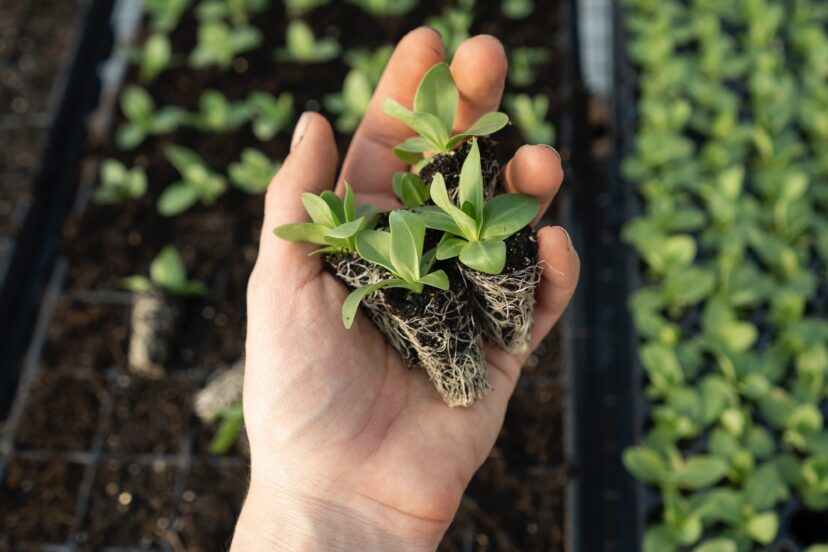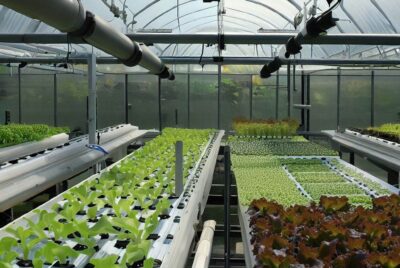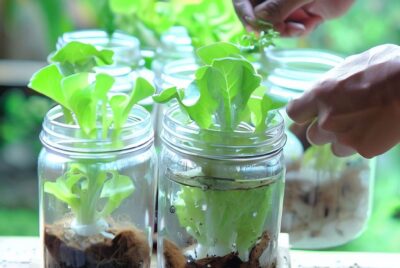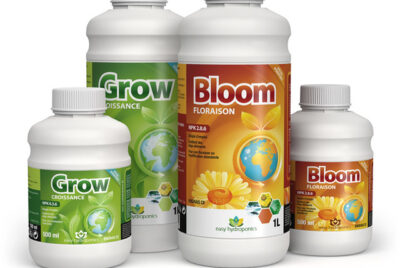Hydroponic Seeds – How to Start Seeds
*We may earn a commission for purchases made using our links. Please see our disclosure to learn more.
As a hydroponic gardener, I have discovered the wonders of growing plants without soil. One of the key aspects of successful hydroponic gardening is starting seeds. Starting seeds in a hydroponic system allows for better control over the growing environment, leading to healthier and more vigorous plants. In this article, I will guide you through the process of starting seeds in a hydroponic garden and provide helpful suggestions.
Hydroponic Seed Starting
Hydroponic gardening is a method of growing plants without soil, using a nutrient-rich water solution as the growing medium. It offers numerous advantages such as efficient nutrient uptake, water conservation, and year-round cultivation. Starting seeds in a hydroponic system is an essential step in the hydroponic gardening journey. It allows you to control the early stages of plant development and ensure optimal conditions for germination and growth.
Benefits of Starting Seeds in a Hydroponic System
Starting seeds in a hydroponic system offers several benefits that contribute to successful plant growth:
- Faster germination: Hydroponic systems provide an ideal environment for seeds to germinate quickly. The optimal conditions for temperature, moisture, and oxygen availability promote faster and more uniform germination.
- Greater control over environmental factors: With a hydroponic setup, you have precise control over factors like temperature, humidity, light, and nutrient levels. This control allows you to create the perfect conditions for seedling development.
- Reduced risk of soil-borne diseases: Starting seeds in soil can expose them to various soil-borne diseases and pests. By eliminating soil from the equation, hydroponic seed starting minimizes the risk of such issues, leading to healthier plants.
- Maximized space utilization: Hydroponic systems are compact and can be set up in small spaces, making them ideal for urban gardeners or those with limited space. Starting seeds hydroponically allows you to maximize your growing area by efficiently utilizing vertical space.
- Year-round gardening: Hydroponic gardening enables year-round cultivation, regardless of the external climate. By starting seeds indoors in a hydroponic system, you can extend your growing season and enjoy fresh produce throughout the year.
Choosing the Right Seeds for Hydroponic Gardening
Selecting the right seeds is crucial for successful hydroponic gardening. Here are a few key factors to consider:
- Variety: Choose plant varieties that are well-suited for hydroponic growth. Certain crops, such as lettuce, herbs, and leafy greens, thrive in hydroponic systems. Consider the specific requirements of each plant and select varieties known for their adaptability to hydroponics.
- Quality: Opt for high-quality seeds from reputable sources. Ensure that the seeds are fresh, viable, and disease-free. Look for trusted seed suppliers or consider saving seeds from your previous hydroponic harvests.
- Hybrid vs. heirloom: Both hybrid and heirloom seeds can be used in hydroponic gardening. Hybrid seeds are known for their uniformity and disease resistance, while heirloom seeds offer genetic diversity and the ability to save seeds for future use. Choose based on your preferences and goals as a hydroponic gardener.
Preparing the Seedlings for Hydroponic Growth
Before transferring the seedlings to your hydroponic system, it’s important to ensure their readiness for the transition. Here are two crucial steps to prepare the seedlings:
Seed Selection and Viability
Check the viability of your seeds before starting the germination process. Seeds that are old or damaged may have reduced germination rates. Perform a simple viability test by placing a few seeds on a damp paper towel and observing their germination rate. Discard any seeds that show no signs of germination after the specified time.
Seed Treatment and Germination
Some seeds benefit from pre-germination treatment to enhance germination rates. Treatments such as scarification (nick the seed coat), stratification (exposing seeds to cold temperatures), or soaking in water can improve germination. Follow the specific requirements of the seeds you are starting and provide the necessary treatment accordingly.
Once the seeds are ready, you can move on to the process of germination.
Setting up a Hydroponic Seed Starting System
To ensure successful seed germination and healthy seedling development, it’s important to set up a suitable hydroponic seed starting system. Consider the following factors:
Selecting a Suitable Hydroponic Setup
There are various hydroponic setups available for seed starting, including nutrient film technique (NFT), deep water culture (DWC), and ebb and flow systems. Choose a setup that suits your space, budget, and the number of seeds you intend to start. Keep in mind the ease of access for monitoring and maintenance.
Choosing the Right Growing Medium
Selecting the appropriate growing medium is essential for seed germination and early growth. Rockwool cubes, peat plugs, and coco coir are popular choices. Ensure the medium has good water-holding capacity, excellent drainage, and sufficient air porosity. Proper moisture retention is crucial for germination, while good drainage prevents waterlogging.
Providing Optimal Temperature and Humidity
Maintaining the right temperature and humidity levels is crucial for successful seed germination. Most seeds germinate best at temperatures between 70-85°F (21-29°C). Use a propagation tray with a transparent cover to create a mini greenhouse effect that traps heat and moisture. Regularly monitor and adjust the temperature and humidity as needed.
Adjusting Light and Photoperiod
Seeds require adequate light to trigger germination and support early growth. Position your seed starting system near a source of natural light, such as a window. Alternatively, you can use artificial grow lights. Choose full-spectrum LED lights that emit the necessary wavelengths for optimal plant growth. Adjust the photoperiod (light duration) based on the specific requirements of the seeds you are starting.
Transferring Seedlings to a Hydroponic System
Once the seedlings have developed strong roots and true leaves, they are ready to be transferred to the hydroponic system. Follow these steps for a successful transplant:
Preparing the Hydroponic System
Ensure that your hydroponic system is clean and free from any debris or contaminants. Check the nutrient solution levels and adjust the pH and nutrient concentrations according to the specific requirements of the plants you are growing. Provide adequate aeration to maintain oxygen levels in the water.
Transplanting Seedlings with Care
Gently remove the seedlings from the growing medium and rinse off any excess medium. Handle the seedlings by their leaves, avoiding touching the delicate stems. Make a hole in the hydroponic medium and carefully place the roots of the seedling into the hole. Gently press the medium around the roots to secure the seedling in place.
Nurturing Seedlings in a Hydroponic System
Once the seedlings are in the hydroponic system, proper care and maintenance are essential for their healthy growth. Pay attention to the following factors:
Maintaining Nutrient Levels and pH
Monitor the nutrient levels and pH of the hydroponic solution regularly. Follow the recommended nutrient solution concentration for the specific crop you are growing. Adjust the pH to the appropriate range (typically between 5.5-6.5) to ensure optimal nutrient availability. Observe the seedlings for any signs of nutrient deficiencies or excesses and make adjustments accordingly.
Monitoring Water and Oxygen Levels
Ensure that the hydroponic system maintains adequate water levels. Avoid overwatering or allowing the water levels to drop too low, as both scenarios can negatively affect the seedlings’ growth. Adequate oxygenation is also crucial for healthy root development. Use air stones or air pumps to maintain oxygen levels in the water.
Providing Sufficient Light
Light is a critical factor for healthy seedling growth in a hydroponic system. Ensure that your grow lights are positioned at an appropriate distance from the seedlings to provide sufficient light intensity. Follow the recommended photoperiod for the specific crop you are growing. Monitor the seedlings for any signs of light stress, such as stretching or discoloration, and adjust the light intensity accordingly.
Maintaining Proper Temperature and Humidity
Maintaining an optimal temperature and humidity level in the hydroponic environment is crucial for the well-being of your seedlings. Most seedlings thrive in temperatures between 70-75°F (21-24°C). Use fans or ventilation systems to maintain air circulation and prevent excessive humidity. Regularly monitor temperature and humidity levels and make adjustments as needed.
Regular Monitoring and Maintenance
Keep a close eye on your seedlings throughout their growth process. Regularly check for signs of nutrient deficiencies, pest infestations, or diseases. Remove any dead or decaying plant material promptly to prevent the spread of pathogens. Maintain a clean and hygienic growing environment to minimize the risk of issues affecting your seedlings.
Conclusion
Starting seeds in a hydroponic system offers numerous advantages, allowing you to have a head start on your gardening season and achieve optimal plant growth. By carefully selecting quality seeds, providing suitable growing conditions, and nurturing your seedlings, you can set a strong foundation for successful hydroponic gardening.
Remember to monitor and adjust essential factors like nutrient levels, pH, light, temperature, and humidity to ensure optimal growth and development. With proper care and attention, your hydroponic seedlings will thrive, giving you healthy plants to enjoy throughout the growing season.
Unique FAQs About Starting Seeds in a Hydroponic System
1 Can I use regular garden soil for starting seeds in a hydroponic system? A: No, using garden soil in a hydroponic system is not recommended. It can introduce pests, diseases, and clog the system. It’s best to use a sterile and well-draining growing medium specifically designed for hydroponics.
2 How often should I check the nutrient solution levels in my hydroponic system? A: It’s recommended to check the nutrient solution levels at least once a week. Adjust the solution’s concentration and pH as needed to ensure proper nutrient availability for the seedlings.
3 Can I reuse the nutrient solution from a previous crop for starting new seeds? A: It’s generally not recommended to reuse the nutrient solution from a previous crop as it may contain imbalances or pathogens. Fresh nutrient solution ensures optimal growth for your new seedlings.
4 How far should the grow lights be from the seedlings in a hydroponic system? A: The distance between the grow lights and seedlings will depend on the light intensity and the specific requirements of the plants you are growing. As a general guideline, aim for a distance of 12-18 inches and adjust as needed based on the seedlings’ response.
5 Can I start seeds directly in the hydroponic system without using a separate seed starting setup? A: While it’s possible to start seeds directly in the hydroponic system, using a separate seed starting setup allows for better control over germination and early growth conditions. It also helps prevent contamination and improves the success rate of seedlings.
Remember, starting seeds in a hydroponic system requires careful attention and regular monitoring, but it can be a rewarding experience that leads to healthy and vigorous plants in your hydroponic garden. Happy seed starting!




